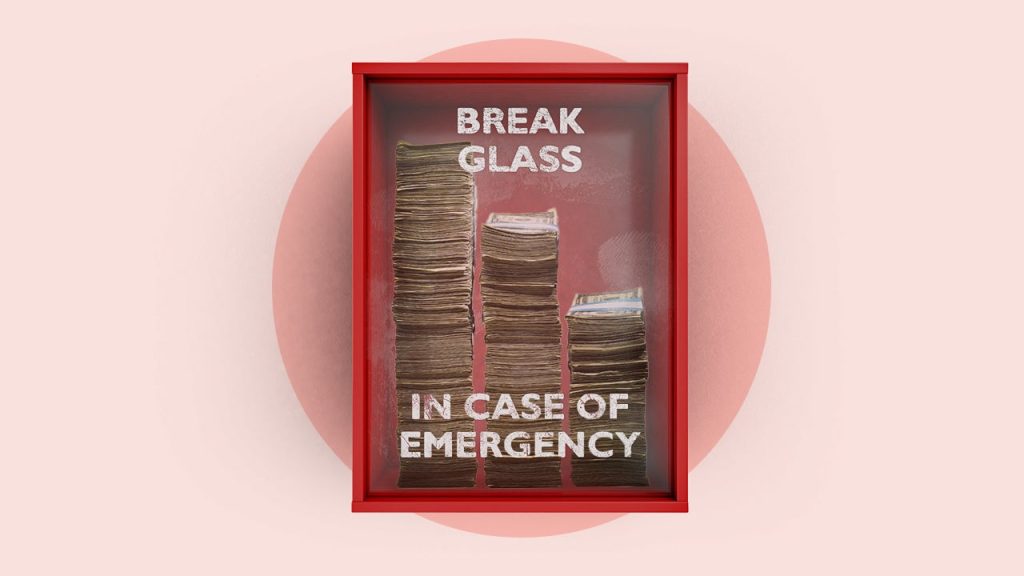Key takeaways
- Borrowing money for an emergency can come with extra costs, like interest, origination fees and penalties.
- An emergency fund can keep you from borrowing money and paying extra for unexpected expenses.
- Alternative options may include nonprofit assistance, payroll advances or zero-interest credit cards.
Even the most organized budgets can fall victim to an emergency. When faced with an unexpected expense, people often dip into their emergency fund. It provides financial protection from debt or loss of other important savings if you’re faced with an unplanned expense or event, such as a car repair or job loss.
While an emergency fund is an essential component to any financial plan, Bankrate’s Emergency Savings Report revealed that, as of May 2024, 27 percent of U.S. adults have no emergency savings at all. Even so, not everyone with savings would use the money in a bind. According to the report, 43 percent of U.S. adults would pay for an unexpected emergency expense (such as $1,000 for an emergency room visit or car repair) by borrowing money in some form.
Financing options like emergency loans, credit cards and payday loans can provide quick funding when you need it, but they often come with a cost, making your emergency even more expensive and your situation potentially more stressful.
The cost of borrowing money to pay for an emergency
From higher interest rates to various fees, loans and lines of credit come with added expenses, making your emergency costlier than if you paid with cash. This is especially true if you get a loan with bad credit. Just how much extra you’ll pay will depend on your unique situation and what loan product you use.
Emergency loan
An emergency loan is a type of personal loan used to pay for unexpected costs in an emergency situation. Emergency loan interest rates typically range from about 7 percent to 36 percent, with an average rate of about 12.46 percent. If you have a good to excellent credit score, you may be able to get the lowest rates. Some lenders also charge an origination fee, which can be up to 10 percent of the loan amount. Other fees can include late payment penalties, insufficient fund fees and prepayment penalties.
While these rates can be lower than other options, emergency personal loans aren’t as popular as other options. According to Bankrate’s Emergency Savings Report, 5 percent of U.S. adults would take out a personal loan to pay for a $1,000 unexpected emergency expense.
Many lenders can approve your loan within 24 hours and fund it within one to three business days. Borrowers receive the money in a lump sum and pay it back in monthly installments for one to 12 years.
True cost example
If you took out a $500 emergency loan — though most lenders have a minimum loan limit above that — with a 12.46 percent interest rate and one-year term, you would pay an additional $45 in total interest over the life of the loan. That makes the true cost of your emergency $545, instead of $500. In other words, 9 cents per dollar borrowed over one year.
Credit card
Credit cards were a popular option for those who said they would pay for an unexpected expense by borrowing money. The Bankrate Emergency Savings Report found that 25 percent of U.S. adults would use a credit card to pay for a $1,000 unexpected emergency. Just like a loan, using a credit card also puts you into debt. The Bankrate Credit Card Debt Survey reported that emergency or unexpected expenses were the second most common reason for credit card debt.
The current average credit card interest rate as of January 2025 is 20.14 percent, which is higher than many personal loans. Instead of receiving funds in a lump sum, a credit card has a revolving line of credit you can draw from and pay back as many times as you need within your limit. Some credit cards come with an annual fee and may include bonuses like cash back or travel miles.
True cost example
Let’s say you put $500 on a credit card with a 20.14 percent interest rate, and it took you one year to pay it off without putting additional charges on the card. You would pay an additional $56 in total interest over the life of the loan. That makes the true cost of your emergency $556 instead of $500. That’s about 11 cents per dollar borrowed.
Payday loan
A payday loan is an unsecured loan that typically must be paid back within 14 days or by your next paycheck. These loans have much lower maximums, around $500, and are some of the most expensive loans available. That’s because lenders typically charge $10 to $30 per every $100 borrowed.
Because these loans don’t require a credit check, people with bad credit may consider them when in a bind. However, due to their high fees and short term, payday loans are not recommended and should only be considered as a last resort if you can repay the amount with your next paycheck.
True cost example
To give you a better idea of how exorbitant this fee is, if you borrow $500 and the finance charge is $30 per $100 borrowed, you will have to pay an additional $150 in fees. That’s $650 total or 30 cents per dollar borrowed, which has to be paid back in a short amount of time.
True cost comparison
The best way to compare what each payment type costs is to look at what you would pay overall.
| Payment method | Amount borrowed | Repayment term | Total paid in added costs | True cost of emergency |
|---|---|---|---|---|
|
Cash |
$0 |
0 years |
$0 |
$500 |
|
Emergency Loan |
$500 |
1 year |
$45 |
$545 |
|
Credit card |
$500 |
1 year |
$56 |
$556 |
|
Payday Loan |
$500 |
2 weeks |
$50-$150 |
$550-$650 |
It may not seem like much when you borrow a lower amount, but if you borrow a higher amount, like $5,000, the total paid in added costs increases dramatically.
| Payment method | Amount borrowed | Repayment term | Total paid in added costs | True cost of emergency |
|---|---|---|---|---|
|
Cash |
$0 |
0 years |
$0 |
$5,000 |
|
Emergency Loan |
$5,000 |
1 year |
$450 |
$5,450 |
|
Credit card |
$5,000 |
1 year |
$560 |
$5,560 |
|
Payday Loan |
$5,000 |
2 weeks |
$500-$1,500 |
$5,500-$6,500 |
The examples are basic calculations that don’t include other fees like origination fees, various penalties and annual fees. The examples also use a loan amount of $500, average interest rates for each loan type and one-year repayment terms.
The credit card example assumes no other charges are placed on the card. The total interest paid and true cost of a loan will depend on the loan amount, your interest rate and how long you have to repay the loan. To get a better estimate of what each payment method will cost you, run your own numbers through a personal loan calculator.
Emergency loan alternatives
While it’s best to pay for unexpected expenses with money from an emergency fund, there are other options that provide the money needed without little to no additional costs. Consider the pros and cons of each emergency loan alternative before choosing the best option for your needs.
Nonprofit or charity programs
Local nonprofits, charities and government programs can provide emergency financial assistance in the form of loans, grants, utility assistance, crowdfunding and other services. While this assistance typically comes at no cost to recipients, there are often qualification requirements and funding may take longer, depending on the needs of the community.
Family or friends
If you have a close friend or family member in a stable financial position with money to lend, you could ask to borrow from them. It’s important to borrow from someone you trust, communicate effectively and set up a payment plan to ensure you don’t strain your relationship. Even if your support system doesn’t have funds to offer, loved ones may be able to offer resources or help in other ways, including cosigning a loan to help lower your interest rate.
Zero-interest credit card
A zero-interest credit card can allow you to borrow money interest-free for a specific amount of time, typically between 12 and 21 months, known as the introductory period. These credit cards can help you save hundreds of dollars on interest, but only work if you pay the borrowed amount off before the intro period is over.
If you don’t pay off the balance before the introductory period, you’ll likely pay interest in the double digits on any remaining balance owed. Keep in mind, too, that the introductory period can end early if you miss a payment or fail to make the minimum payment.
Payroll advance
A payroll advance is a loan from your employer to help cover an expense between pay periods. It’s essentially getting a portion of your paycheck early, except your employer may charge a small fee to cover administrative costs.
You’ll pay the advance back through future payroll deductions. That means future paychecks will be less than your normal pay. Not all employers offer payroll advances. Speak to your HR or payroll department to learn more or research cash advance apps.
401(k) loan
Borrowing from your retirement isn’t ideal, but using a 401(k) loan can provide you with funds quickly without a credit check. While you will pay interest on the loan, that money goes back into your account. Additionally, you won’t pay the taxes and early withdrawal penalties that come with pulling money from your account because it’s a loan you pay back. To avoid these fees, you must pay the loan back within five years in most cases.
If you leave your job, you’ll likely need to repay the loan in a much shorter period. A 401(k) loan also inhibits your fund from growing to its full potential. Before borrowing from your retirement, consider that any money borrowed loses its ability to grow tax-free over time.
How to build your emergency fund before you need it
An emergency fund can help you avoid debt and keep you from dipping into other savings, including your retirement accounts. How much you should save in your fund will depend on your monthly expenses, income and financial situation.
Many experts recommend building your emergency fund to cover three to six months’ worth of expenses. If that number feels overwhelming, focus on a smaller, more attainable goal, like $100, then move the goal post once you hit that number. Another option could be to start by saving the amount of your insurance deductible, which could help cover home, medical or auto emergencies.
To build your fund, review your budget and see where you can spare some money to put into your savings, starting small and gradually building your contributions. A few tricks to saving include:
- Automate your savings to transfer a certain amount of money from your checking account to a savings account on payday.
- Keep your emergency fund separate from other savings.
- Put your emergency fund in a high-yield savings account to earn more interest on your savings.
- Put financial windfalls, like a bonus, inheritance or tax refund, into your emergency fund.
- Celebrate your saving successes to stay motivated.
Bottom line: Borrowing in an emergency comes with added costs
If you want to avoid making an emergency more expensive, the best way to pay for an unexpected cost is with cash. Borrowing money through a loan or line of credit comes with added costs that may include interest, origination fees, penalties and annual fees.
Depending on how much you borrow, your interest rate and repayment term, these additional costs could increase the cost of your emergency by hundreds or thousands of dollars. Creating a savings account dedicated to unexpected costs is one of the best ways to avoid borrowing money during an emergency in the future.
Read the full article here










